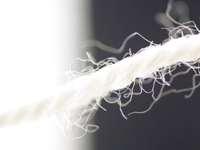Without a trace
“Every contact leaves a trace.” This is the basis of forensic science. At every crime scene, the criminal unwittingly leaves clues behind, and also takes things away. This evidence is often microscopic, such as clothing fibres, plant pollen, soil particles, or tiny fragments of glass or paint. The job of forensic scientists is to compare samples from the scene with those taken from a suspect. Each match makes it more likely that the suspect was at the scene.
Have you ever wondered how scientists study such small samples?
You might like to …
• look at microscopes in your laboratory and in catalogues; find out the highest magnification an optical microscope can give, and thus how small an object can be and still remain visible under a microscope
• study some optical and electron photomicrographs; find out the obvious advantages of using an electron microscope (apart from magnification)
• look at natural and synthetic fibres under a microscope; describe the differences which could help you to distinguish between wool, cotton, nylon and polyester
• compare pollen grains from different types of plant (note: you’ll need high magnification for this)
• study paint fragments; look for different layers of paint; describe how this might help a forensic investigation
Further links:
(pages 29 – 45)
Have you ever wondered how scientists study such small samples?
You might like to …
• look at microscopes in your laboratory and in catalogues; find out the highest magnification an optical microscope can give, and thus how small an object can be and still remain visible under a microscope
• study some optical and electron photomicrographs; find out the obvious advantages of using an electron microscope (apart from magnification)
• look at natural and synthetic fibres under a microscope; describe the differences which could help you to distinguish between wool, cotton, nylon and polyester
• compare pollen grains from different types of plant (note: you’ll need high magnification for this)
• study paint fragments; look for different layers of paint; describe how this might help a forensic investigation
Further links:
(pages 29 – 45)


